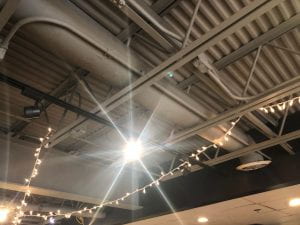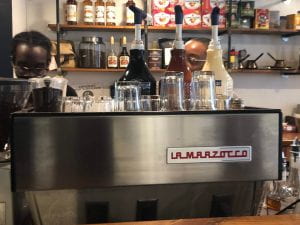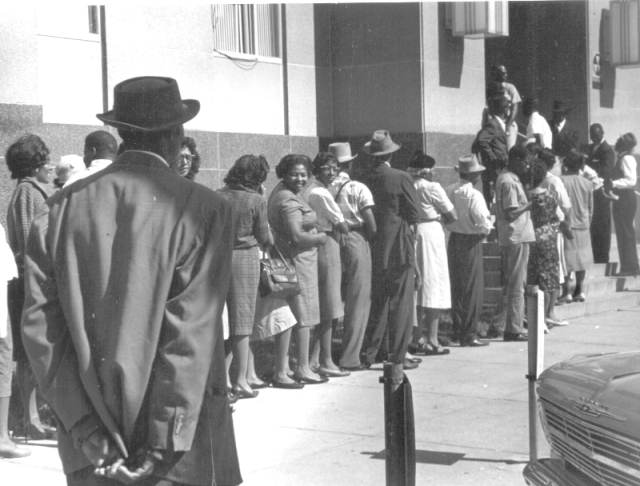I am a freshman at Georgia State University, who constantly travels to Ebrik Coffee Room in order to study for my classes. The dehumanization of baristas shown is important for me to describe as it affects my life currently as well as many of the individuals in the US. I chose Ebrik Coffee Room as it perfectly exemplifies this problem and is in the heart of urban Atlanta, as it lies directly on GSU campus. Ebrik Coffee Room is located at 22 Park Pl SE, Atlanta, GA 30303. I have experience working as a barista at Starbucks, so I have spent countless hours in coffee shops, both as an employee and as a customer. I have seen the effects of this issue first-hand through the lives of co-workers and customers walking into the shop at varying times of the day. I think that the sharing of my experiences can help spark change higher up in corporations in coffee.
Ebrik Coffee Room is a very large coffee shop with a rustic, yet homely interior. It sits square in the center of urban Atlanta, surrounded by blocks of buildings. The people sitting away from the busy coffee bar are smiling, as they already have their drinks. The patrons standing near the bar are continuously moving, seemingly restless. They continue to tap their feet nonstop, not to the rhythm of the music. The
barista shouts a name and then carefully placed a cup down on a dark table in front of her. A man in a suit paced over, grabbed the coffee, and immediately sat down, letting out a large sigh. His movements were less erratic, and much calmer. He stopped tapping his feet or checking his watch, and simply focused on his laptop in front of him.
Baristas are standing behind shiny, metallic espresso machines, constantly fuming with steam. Propped up behind them is a large, dirty chalkboard with a large variety of drinks, ranging from $3 to $7. Music is blaring from behind the wooden bar, unintelligible due to the roaring voices of patrons, all mumbling over one another. The ceiling is very raw, only consisting of metallic scaffolding with scratches and dents, propping up spotlights shining on the baristas revealing gleams of sweat trickling down their faces. Their movements are incredibly precise and efficient, as all their actions seem like one large, swift dance. Without slowing down at all, they move from grinding the coffee beans incredibly fine, pulling the shots of espresso, steaming milk, and adding the correct ratios of a seemingly endless variety of ingredients to the cup. They add latte art to the top of the drinks, and then immediately cover it with a lid.
Despite their efforts, the line of people continued to grow larger and larger, increasing the workload of the baristas. As the line grew, the path of cups with instructions started to topple, creating a stack of 8+ cups in a que of beverages to make in an almost inhuman amount of time. The customers continued to wait impatiently, looking past the baristas into their phones and at the table with finished drinks. All the lights in that area were focused solely behind the bar, as if they were the main event, yet no one seemed to give them more than a glance. Sitting above the espresso machine are many pumps of caramel and other assorted sauces, placed such that the barista’s face is covered
almost entirely at certain angles. The baristas are wearing no nametags and are only identifiable by their aprons. Hidden next to the cash registers, just to the left of the sauces is the tip jar, barely filled with $1 dollar bills.
Throughout the line of customers, there are two children under the age of 10. They are standing with an adult in line, slowly inching forward toward the baristas. As the kids looked towards the baristas, their eyes widened. As they slowly inch forward, the adult never looks at the barista. Her eyes veer towards the chalkboard, espresso machines, and her kids, yet she never looks at the barista. Her children attempt to get a closer look at the proficient movements of the baristas but are blocked by the various cluttered goods on top of the bar and espresso machines. As they move away from their adult to get a greater look, she pulls them back, grabbing their hands with a firm grip.
A man in a button up shirt with a dark red tie walks out from the back of the bar and silently stares at all the customers in line and the number of cups in cue. Immediately after seeing the large stack of cups, he assertively marches over to the baristas, whispering something in their ears, causing them to start working much faster and harder than they already are, attempting to finish their drinks as fast as possible. The barista’s facial expressions look panicked, as there is a forced smile on their face that pulsates in and out of existence. The man stands back and stares at the customers and employees for a few more minutes, aggressively nudging at both workers occasionally to speed up even more. 30 minutes to an hour goes by, yet the number of customers arriving and waiting never seems to lower, and the amount of money in the tip jar never seems to increase.
The baristas have an absurd workload, yet people still expect to get their coffee as fast as possible. Rarely do people ever consider how much work the barista must do in order to make their drinks in a timely fashion. The people do not look at the baristas as people, rather as robots. This is why the spotlights are focused behind the bar, effectively treating them as an attraction, or conduit, rather than human beings. Regulations set by higher ups are the reasons why pumps of syrups are placed in front of barista’s faces and why tip jars are placed in obscure positions, away from the customer. The baristas are not given name tags, effectively dehumanizing the baristas. The case of the two children and their adult supervisor perfectly illustrates how the adult completely disregards the actions and hard work of the barista while the children seem mesmerized by the efforts of the employees. The only way to end the dehumanization of baristas and the way that patrons view them is to fundamentally change the way that coffee shops are organized. Change can only trickle down from the top.




